|

by Linda Moulton Howe
August 2006
from
EarthFiles Website
August 19, 2006 Cardiff, Wales
Nearly
half a century ago in 1960, a mathematics graduate student from
Colombo, Sri Lanka, set off on his first international trip to
Cambridge, England.
His name is Chandra Wickramasinghe. He was
fascinated by stars in the night skies, wondered about other life
Out There, and his Cambridge University advanced degree was in
Astronomy. His faculty supervisor was the famous Cambridge
astronomer, Fred Hoyle. The two men had the curiosity and courage to
look for other life in the universe by studying cosmic dust.
Their
controversial panspermia hypothesis was that the universe is teeming
with at least microbial life, which can be transported from one
cosmic location to another.
In their collaboration, the two
astronomers felt strongly that the double helix DNA found in all
Earth life had been seeded here by comets or other cosmic bodies and
that same DNA would be found in all life forms throughout the
cosmos.
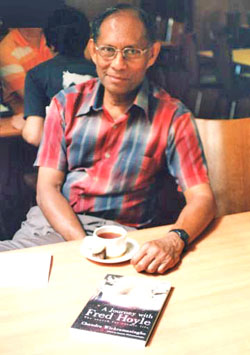
Chandra Wickramasinghe, Ph.D. and S.C.D., Cambridge University,
Prof. of Applied Math and Astronomy and Director of the Cardiff
Centre
for Astrobiology, Cardiff University, Cardiff, Wales, U.K.
Now, there is a discovery in rainwater that fell on the southwestern
tip of India in the state of Kerala, which is challenging the idea
that all DNA in this universe is the same.
Five years ago in July 2001, Kerala residents said they heard a loud
boom. Then red rain fell, which stained white clothes. News of the
red rain mystery reached Dr. Godfrey Louis, a physicist at Mahatma
Gandhi University in Kerala. He collected many test tubes full of
the red-colored rainwater and put some of the odd liquid under a
microscope.
He was struck by the beautiful rust color of what seemed to be
living cells. The cell diameters averaged 10 microns, a little
bigger than a human blood cell, which is about 7 microns.
Dr. Louis reported as many as 15 ďdaughter cellsĒ budded within one
ďmother cellĒ and then broke out of the adult cell. That was clearly
a process of replication. In normal Earth biology, replication
requires the presence of DNA. But Dr. Louis could not find evidence
of DNA in the multiplying cells in his test tubes.
Eight months ago, in January of 2006, Dr. Louis contacted astrobiologist,
Chandra Wickramasinghe, now at Cardiff University in
Wales. Soon Prof. Wickramasinghe had some vials of the red rainwater
to study and sent some to biologists at Sheffield University in
England. Americaís Cornell University also received some red rain
samples to analyze isotopic ratios. Elements confirmed so far are
hydrogen, silicon, oxygen, carbon, and aluminum. But, there still is
no definitive confirmation of DNA, or what makes the cell walls red.
This month on August 7 to 8, I was in the Microbiology Lab at
Cardiff University to see the red rainwater for myself and to talk
with Prof. Wickramasinghe and his graduate student, Nori Miyake.
Nori has tried to break open the cells to amplify whatever DNA might
be there. Nori showed me the pale pink rainwater in test tubes.
Nori told me he has never seen such thick, hard cell walls, which he
could only partially penetrate. He is concerned about contamination
in the fluorescent techniques he tried, which indicate there might
be DNA. But in his fluorescent research, there have been variables,
which might be false positives.
He does not even know if he ever
extracted anything from the red cells because the walls were so
thick and hard to break.
Cardiff University Microbiology Lab -
August 8, 2006
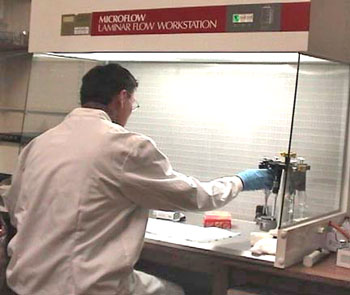
Norimune Miyake, Ph.D.-student, Astrobiology, Cardiff University,
Cardiff, Wales.
Since Since March 2006, "Nori" has been trying to break into the
thick-walled Kerala red rain
cells to amplify whatever DNA might be there.
So far, DNA
confirmation has not happened.
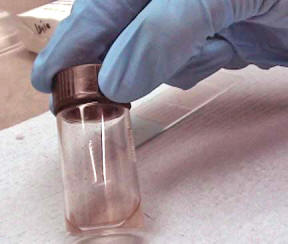
Above and below: Nori shows red rain collected from Kerala, India,
in 2001 by physicist
Godfrey Louis, Ph.D., Mahatma Gandhi University.
Photographs © 2006
by Linda Moulton Howe.
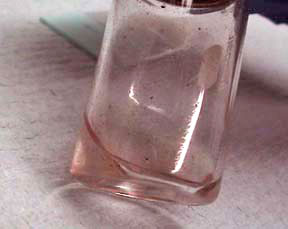
Light Microscope - Single Red Rain Cell
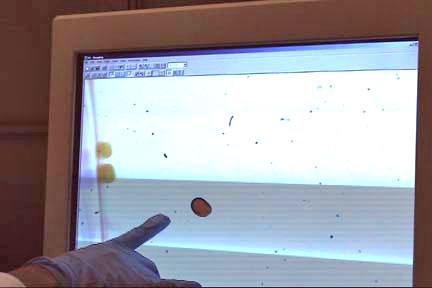
Norimune Miyake points to single red rain cell isolated in his light
microscope,
Microbiology Lab, Cardiff University, Cardiff, Wales.
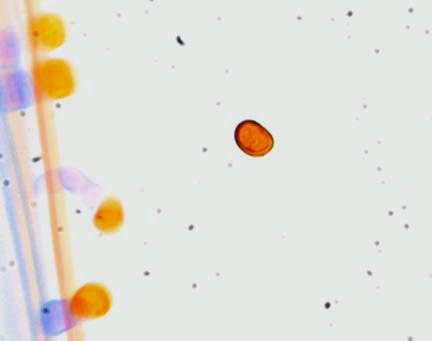
Ten-micron-diameter Kerala red rain cell under light microscope.
2006 photomicrograph courtesy Cardiff University.
Norimune Miyake, Astrobiology Ph.D.-Student:
"This is the light
microscope image of the red rain sample. Here you can see single
cell. This is a red rain cell. We have millions of those and I
managed to photograph one single cell. Here you can see the upper
surface of the cell. From the light microscope, what you can see is
the color of these cells. Here you can see red color, or orange-red
color. This is the cause of the color in the rain.
YOU DONíT KNOW EXACTLY WHAT IS CAUSING THAT COLOR?
No, it hasnít been identified."
DAPI-Stain Fluorescence: Is it DNA? Or False Positives?
[Editorís Note: DAPI = 6-diamidino-2-phenylindole (DAPI) to stain
DNA, 3,3'- ... DAPI can be used on fixed or living cells, DiOC 6
must be used on living cells.]
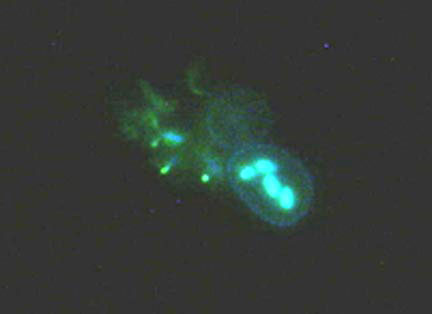
DAPI-stained red rain cells. Foreground cell clearly shows four
fluorescing "daughter cells"
which have budded inside the "mother cell." But the red rain cells
variably autofluoresced,
confusing the issue of definite DNA.
2006 photomicrograph courtesy
Cardiff University.
" I stained the cells with a substance called
DAPI, which fluoresces
the DNA. Hopefully, if there is DNA, it could glow. It will stain
and glow. I did get positive results. These are images of two cells
after I stained and gave the light. Here you can see four daughter
cells inside the mother cell do glow. So, I can say in these four
daughter cells per cell, there appears to be concentrated DNA.
But
another thing is that I also saw that these red rain cells autofluoresce. That means without introducing the light, they glowed
by themselves.
[Editor's emphasis.] But I have found that the red rain cells only
glow in red color and not in blue color.
If the DAPI does not bind to DNA, it will wash out. So, even if you
give the light, it wonít glow. But if DAPI binds to DNA, it will
stick there so if you give the light, DAPI will glow. Then you know
DNA is there.
THEN WHY IS THIS NOT PROOF THAT THERE IS DNA?
Because I have shown in other research work that the red rain cells
glow, autofluoresce, in other colors. They ought to fluoresce in
blue color, but there is a possibility of interruptions we havenít
identified yet. Perhaps DAPI interrupts with autofluorescing
mechanisms in the red rain. There is a possibility of such effect
and thatís why we cannot definitely say there is DNA.
THIS FLUORESCENCE HAS NOT PROVED ANYTHING ABOUT DNA IN THE RED RAIN
CELLS?
Not totally, not definitely. To get definite results of DNA, the
best way is to break open the cells and get the DNA, PCR the DNA,
and then sequence it. That would be a definite answer for DNA."
[Editor's Note: PCR = Polymerase chain reaction (PCR), which has
become one of the most widely used techniques in molecular biology
to produce relatively large numbers of DNA molecule copies from very
small quantities of source DNA material - even when the source DNA
is of relatively poor quality.]
Thick Cell Wall of Red Rain Cell
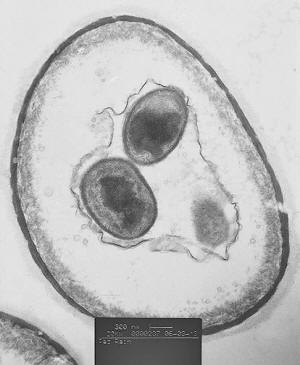
This photomicrograph (scale bar is 300 nanometers) shows a
thick-walled red rain "cell containing
'daughters' - two have well-defined cell walls, while the third
(paler) structure (lower right) might be a further
daughter in the process of development."
Photomicrograph
courtesy Cardiff University.
THE REASON WHY YOU HAVENíT BEEN ABLE TO BREAK THOSE CELLS IS?
I can show you now. We have images from the TM work. This TM image
shows that the cell has a very thick wall. Using normal lyces
techniques, I cannot break open these cell walls. Thatís why I
couldnít get anything from inside.
SO THESE ARE EXCEPTIONALLY THICK CELL WALLS IN THE RED RAIN?
Yes.
WHAT WOULD MAKE THE WALLS SO THICK?
One possibility is a mechanism like spores in which the cell walls
protect the inner cells. I havenít found out what the cell walls are
made of.
IF THIS IS EXTRATERRESTRIAL LIFE FROM OUTER SPACE AND ENDS UP NOT
HAVING DNA, WOULD THESE THICK WALLS PERHAPS BE PROTECTIVE FOR LIFE
IN OUTER SPACE?
Yes, it is possible. With the color and thick cell walls, the most
toxic thing in outer space would be the radiations and solar
energies. It is possible, these can protect the cells from that and
keep them from drying out inside the cells.
SO, WHAT MAKES THE RED COLOR IS STILL UNKNOWN, THE CELL WALLS ARE
VERY THICK, AND DNA HAS NOT BEEN CONFIRMED?
Thatís correct."
The Cardiff lab director, David Lloyd, told me he thinks the
rainwater cells might be some kind of Earth yeast cells, which also
replicate by internal budding. He postulates that some kind of yeast
rose up into the clouds over Kerala, multiplied into literally tons
of cells, which then came down in the multiple rains.
But Dr. Lloyd cannot explain why there would be red rains only in
the summer of 2001, and none reported before or after Ė until July
2006. There was another red rainfall in July this year over Kerala,
almost exactly five years to the day of the first red rain.
In June, when I interviewed
Prof. Wickramasinghe for Earthfiles and
Dreamland, he was reluctant to give up on the red rain cells having
recognizable Earth DNA.
But by August 8th, his mind was opening to
the possibility that his and Fred Hoyleís panspermia theory might
now have to accommodate other life in the universe that might not be
exactly like Earthís.
Interview
Chandra Wickramasinghe, Ph.D. and S.C.D., Cambridge University,
Prof. of Applied Math and Astronomy and Director of the Cardiff
Centre for Astrobiology, Cardiff University, Cardiff, Wales, U.K.:
ďOn the basis of the evidence that Iíve seen, I have to come on the
side of an extraterrestrial origin for the red rain cells. I think
the first injection of these cells into 2001, or even earlier than
that, most likely came from space.
IS IT FAIR TO SAY IF I SUMMARIZE THAT ON THE ONE HAND, WE HAVE THE
SOUND OF THE BOOM THAT MIGHT RELATE TO AN INCOMING CHUNK OF ICE THAT
COULD HAVE BEEN CARRYING SOMETHING THAT RESEMBLES YEAST CELLS, BUT
IT CAME FROM OUTER SPACE AND REPLICATED IN THE UPPER CLOUDS?
OR IT WAS A RED YEAST FROM OUR EARTH THAT ROSE UP IN THE AIR FOR
SOME REASON AND REPLICATED IN THE CLOUDS? THAT THOSE ARE THE TWO
SPECULATIONS: ONE TERRESTRIAL AND ONE NON-TERRESTRIAL?
I think those are the two contending theories that the sonic boom
that was heard was a source of the red rain cells. Perhaps a small
comet or piece of comet exploded and brought the material, either
the whole of the material that went into the red rain, or a minute
fraction that was then multiplied in the clouds.
Alternatively the red rain was something that was just lofted up
from the surface of the Earth, maybe from the trees and wind and so
on. I personally find that almost incredible that these are Earth
organisms that could have been lifted in such great quantities into
the clouds. They donít look like Earth organisms in the details that
are available at the moment. There are some generic similarities to
yeast cells, but doesnít exclude yeast cells coming from outer space
Ė a totally different yeast type cell with totally different DNA. Or
maybe no DNA, as we still have to determine.
So, I think there is a continuing puzzle. But between the two
alternatives, an Earth-based origin and an origin from space, I
would err on the side of an origin from space.
Another Kerala, India, Red Rain in July 2006
COULD YOU EXPLAIN ALSO ABOUT THE JULY 2006 RECENT RED RAIN?
Yeah, this was something that was quite surprising. I found the news
on an Internet site and got hold of Godfrey Louis and friends in Kerala, and they confirmed there was such an episode almost five
years to the day after the events of 2001.
SO THIS WOULD HAVE BEEN IN JULY 2006?
July 2006. Now, how does one explain this? I think it is very
difficult to explain that in terms of an earthbound cycle, some
replication cycle of yeasts on the ground, a five-year replication
cycle. That does not make too much sense.
On the other hand, comets have periods that vary from 3 years to
very long periods. Halleyís Comet is over 80 years period and so on.
So, there is a whole range of periods associated with comets and one
could easily imagine a stream of cometary particles with a period of
precisely 5 years and the Earth crossing this stream on a regular
basis. Why that stream crossed over into the Earthís atmosphere at Kerala might remain a problem. But I think there are ways of
explaining that as well.
WHY KERALA IN THE SOUTHWEST CORNER OF INDIA AND NOT OTHER PLACES ON
OUR EARTH?
I think other places on the Earth also would have been receiving
these red rain cells. But it would not be noticed. If you think a
belt of latitude that goes around the Earth where Kerala is, then
east of Kerala is the Indian Ocean all the way to the Sahara. And
going West, you have mountains. So, if this red rain fell over a
huge strip of land going all the way, or half the way, around the
world, Kerala might have been the only place with a population able
to detect it.
But why the latitude of Kerala? That might be the problem. The
Earthís latitude at Kerala seems to be implicated in some way and
that might be related in some way to where the cometís stream
intersects the Earth.
THAT LATITUDE OF KERALA IS WHAT?
I would think about 10 degrees north of the equator.
BUT TO DATE, THERE IS STILL EVEN A MYSTERY ABOUT WHY THERE WOULD BE
REPETITIVE RED RAINS IN KERALA, INDIA?
There is a mystery of almost unparalleled proportions in terms of
any terrestrial biological cycle. If you can think of any
Earth-bound cycle that has a 5-year period, in yeast cells that is
very difficult to come up with. To me, that is a clear indication
that this is driven from outside.
But on the existence of DNA, there still remains a considerable
uncertainty. I would like to think that wherever the cells came from
Ė whether from the Earth or from space Ė that they had DNA, simply
because that is the kind of life that Iím used to thinking of Ė that
all life on Earth is based on DNA. So, it would be a great surprise
if there were red biological cells that did not contain DNA.
But the arguments of
Godfrey Louis, I think, are quite important to
explore. And to this day, we havenít had definitive evidence of DNA
from the tests that were done by Nori. There were fluorescence tests
that were used, very standard tests (with DAPI), and they do show a
positive for DNA. But itís well known that these could be false
positives. There is really no 100% detection of DNA, based on
fluorescence.
What Would Decide DNA Question?
The really crucial test would be to
break open the cells and to
extract DNA and then to try to amplify the DNA and see whether there
is DNA and if it is similar to such and such cell type that we
recognize. There are two things to say about this: the breaking of
the cells turned out to be exceedingly difficult. The cell walls
were robust, almost beyond belief.
It was really a mammoth task to
extract DNA from the cells, which we think we have done. Nori is the
person who works in the lab and he was able to break the cells open
and extract some DNA, but so far we have not been able to amplify
that DNA and to really make sure that the DNA is something that came
from the cells. It is very easy to have contaminants in the process
of breaking the cells and extracting what is inside them.
I THOUGHT THAT NORI HAD SAID THAT HE WAS NOT HAPPY WITH WHAT HE HAD
BEEN ABLE TO DO WITH THE CELL WALLS SO FAR Ė THAT HE DID NOT FEEL HE
HAD ACTUALLY BEEN ABLE TO PENETRATE THEM THE WAY HE WANTED TO
EXTRACT MATERIAL AS HE NORMALLY WOULD WITH NORMAL CELLS?
I think thatís true. When I looked at some of the electron
microscope pictures and optical microscope pictures of these broken
cells, there was evidence of broken cell walls and fragments of
cells. But there was also very little evidence of anything that came
out of those cells. I think thatís the bottom line. We have to
identify something that came out of the cells as being the DNA that
we try to amplify.
THAT IS ACTUALLY PART OF THE RED RAIN CELL AND NOT SOME POSSIBLE
CONTAMINANT FROM THE PROBLEM OF PENETRATING THE CELL?
Thatís right. The problem of penetrating the cells was horrendous.
He had to use various techniques of using water ice, for instance,
and then cracking open the water ice. They were techniques that were
very prone to introducing contaminants. To me, these are the
uncertainties that we have at the moment.
Thick Cell Walls and Red Color - UV Protection?
IF THE CELLS DID COME IN ON A PIECE OF COMETARY ICE IN 2001
ORIGINALLY, AND THAT THEY ARE CELLS FROM OUTER SPACE, IS IT POSSIBLE
THAT THE THICKNESS OF THE CELL WOULD HAVE EVOLVED BECAUSE IT NEEDS
SOME KIND OF SERIOUS PROTECTION IN AN OUTER SPACE ENVIRONMENT?
I think itís true that the thickness of the cell wall is a great
protection against ultraviolet radiation. So also is the red
pigment. Whatever the red pigment is comprised of, also could be a
protection against UV light. I think all the indications to me are
that these cells can withstand very harsh conditions Ė the
conditions of high-speed entry to the Earthís atmosphere and also
could understand high doses of ultraviolet radiation.
We would like to do experiments to verify this, to subject the cells
to high doses of UV and see what happens to them. These experiments
have not been done yet. We are planning them in the near future.
NOW, THE IDENTITY OF THE RED PIGMENT Ė ITíS BEEN FIVE YEARS NOW
SINCE THAT FIRST RED RAIN. WHY DO YOU THINK THAT RED PIGMENT, OR
WHATEVER MAKES THE CELLS RED, HAS NOT YET BEEN IDENTIFIED?
The samples were available to us only relatively recently. So we
havenít had much time to do all the tests that are possible. I think
the tests so far would exclude a heme, an iron-based pigment.
Carotenoids, which are the other red-yellowish pigments Ė they seem
to be a strong candidate for the red coloration, as they do occur in
certain yeasts. We know that there are many types of yeasts that
have reddish pigments and they are carotenoids Ė not anything like
hemoglobin or related to hemoglobin.
IN THE YEASTS THAT WE KNOW, WHAT PURPOSE DOES THE RED PIGMENT SERVE?
I think that for the yeasts in the atmosphere that are blown around
in the Earthís atmosphere, some yeasts have also been discovered
high in the sky in the clouds, for example. If they were to survive
conditions in the upper atmosphere, a pigment would be of great
importance to screen the DNA from ultraviolet radiation.
YOU MEAN THAT THE RED PIGMENT COULD SERVE AS SOME KIND OF FILTERING
MECHANISM?
Yes, as a filtering mechanism. It is known, I think, in the case of
many pigmented bacteria and pigmented microorganisms generally that
red pigments serve precisely this purpose.
IT WOULD BE FILTERING UV. ONE SPECULATION WAS THAT PERHAPS THE RED
PIGMENT MIGHT PROVIDE THE ENERGY FOR THE CELL IF YOU CANNOT FIND
DNA?
I think so. It could be a light-harvesting device as well. Pigment
takes up a color, red or yellow or something, because it responds to
sunlight in a certain way, it absorbs particular colors in sunlight.
The radiation that is so absorbed could also be light-harvesting,
could produce energy, and could be an energy source for the cell.
Living Cells Without DNA?
IF YOU ARE DEALING WITH EXTRATERRESTRIAL CELLS FROM SOME PLACE ELSE
THAT CAME INTO THE EARTHíS ATMOSPHERE ABOVE KERALA IN SOME KIND OF
COMETARY ICE, AND IF IT TURNS OUT THAT YOU AND SHEFFIELD AND CORNELL
CANNOT CONFIRM DEFINITELY DNA, WHAT ARE THE IMPLICATIONS IN YOUR
THINKING FOR A LIFE FORM THAT LOOKS LIKE A YEAST CELL, BUT DOES NOT
HAVE DNA?
I suppose Iíve got to re-think my entire framework of scientific
orthodox beliefs that DNA is crucial to life. That may not be true
anymore. If this is proved to be a biological entity that replicates
without DNA, then one has to look for another system, a non-DNA
system that can hold information. What DNA does is hold the
information that is needed to reproduce.
I just canít think of any other mechanism or other chemical system
at the moment, but that does not mean that there is not such a
system. It could be that an alien life evolved a system that is not
based on DNA. There have been speculations about silicon-based life
and so on.
But in this particular instance, the cells we are seeing are
carbon-rich and they have all the normal carbon, nitrogen, oxygen
abundances, so itís not an alien life such as a silicon-based life
or totally alien chemistry thatís involved.
So, it would surprise me if there is absolutely no DNA. But on the
other hand, itís also an indication that we just donít know anything
about biology that might exist on a bigger scale outside of the
Earth. I think we have to keep an open mind as to what types of
biology exists on a cosmic scale.
COULD THE RED PIGMENT ITSELF BE SOME KIND OF AN INFORMATION-CARRYING
DEVICE IF THERE IS NO DNA?
Not really because I think the molecules that are pigmented usually
are carotenoids, they are not long chains of information-carrying
systems. So, I think thatís probably unlikely.
WHAT IS YOUR GUESS ON THE RED RAIN OF KERALA IN TERMS OF BEING ABLE
TO PROVE THAT IT CAME IN FROM OUTER SPACE ON A COMET?
That is a very difficult issue to resolve with absolute certainty.
If there were no DNA, then that would be an indication that it was
almost compelling in the direction of an alien incursion. If there
is DNA, then one has to analyze the DNA and make sure the DNA is
totally disjointed from any living form, any known type of yeast
that exists on the Earth. I think that would also be an indicator of
an alien invasion.
That would be the closest one would get to complete proof and I tend
to think that sooner or later, something like the red rain would
happen that would be the smoking gun for panspermia, which would
decisively demonstrate that we are not alone, that our life here is
connected to a much bigger life system in the cosmos.Ē
In mid-September 2006, Prof. Wickramasinghe will host 30
astrobiologists from around the world at Cardiff University,
including Dr. Godfrey Louis, who is flying in from Kerala, India, to
present his research on the red rain cells since 2001.
Dr. Louis has
published data [April 4, 2006, journal Astrophysics and Space
Science, ďThe Red Rain Phenomenon of Kerala and Its Possible
Extraterrestrial OriginĒ] which states that the Kerala red rain
cells increase replication of the daughter cells in the mother cells
when subjected to high pressures and temperatures in the range of
300 degrees Celsius (570 degrees Fahrenheit).
So far, Dr. Louis's
work has not been reproduced, but it's research that Norimune Miyake
and others would like to do.
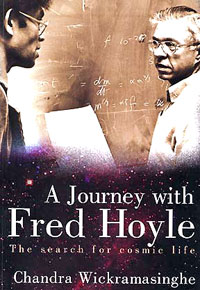
Chandra Wickramasinghe on right with Prof. Fred Hoyle in 1977,
at Cambridge University. Prof. Hoyle died at age 86 in August 2001.
A Journey with Fred Hoyle: The search for cosmic life
© 2005 by
Chandra Wickramasinghe
More Information
Ripley's Believe It Or Not
- 1928 Issue -
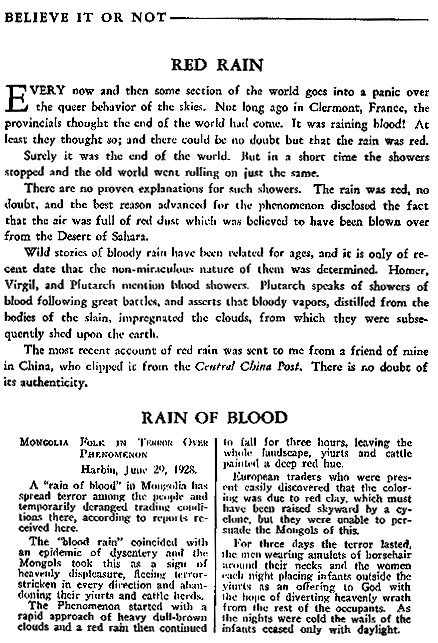
|










